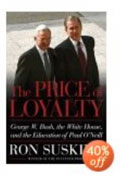Book
Reviews: The Price of Loyalty: George W. Bush, the
White House and the Education of Paul O’Neill
 Ron
Suskind, The
Price of Loyalty: George W. Bush, the White House and
the Education of Paul O’Neill (New York: Simon & Schuster,
2004). 348 pages. $26.00.
Ron
Suskind, The
Price of Loyalty: George W. Bush, the White House and
the Education of Paul O’Neill (New York: Simon & Schuster,
2004). 348 pages. $26.00.
Reviewed
by Scott B. MacDonald
 Click
here to
purchase Ron Suskind's book, "The
Price of Loyalty: George W. Bush, the White House
and the Education of Paul O’Neill ",
directly from Amazon.com
Click
here to
purchase Ron Suskind's book, "The
Price of Loyalty: George W. Bush, the White House
and the Education of Paul O’Neill ",
directly from Amazon.com
It
is the election season and any book that provides insight
into the main actors on the political stage will get considerable
attention. Hence, Ron Suskind’s The Price of Loyalty
is timely as it provides a verdict about one of the men
contending to be in the White House post-November 2004 – George
W. Bush. Seen through the eyes of former Treasury Secretary
Paul O’Neill, this portrayal of the Bush White House
is not flattering. Indeed, the book is really Mr. O’Neill’s
well-timed and carefully thought revenge on a White House
crew – Dick Cheney, Karl Rove and other close political
associates – that came to constitute a praetorian
guard that encircles the President and made the bringing
of any new ideas virtually impossible.
What was galling to O’Neill is that the Republican White House under
Bush, Jr. was not like prior Republican White Houses, which placed an emphasis
on a rigorous process of examining issues and finding pragmatic solutions.
Instead, George W. Bush, Jr. appeared to have a disdain for any such process,
took the advice of a handful of advisors (mainly on the political side)
and said very little to provide his cabinet ministers with any guidance
on policy. According to Suskind, O’Neill warned Vice President Cheney
that “without a process that included strongly positioned honest
brokers and a rigorous, disinterested vetting of various proposals, “all
you’ve got are kids rolling around on the lawn.”
In a sense, the hardcore issues – tax cuts, 9/11, treatment of developing
world economic problems, and how to stimulate the U.S. economy – are
a backdrop as to the real issues in the book - the price of loyalty. In
O’Neill’s mind, the process is necessary to reach policies
that are in the best national interest. The President, his advisors and
cabinet ministers are there as they have the nation’s best interests
at heart. Their loyalty transcends ideology. In contrast, the Bush White
House, dominated by the political crew of Karl Rove and the dark eminence
Vice President Cheney (former friend and betrayer of O’Neill), had
their loyalty to the Bush family. As Suskind wrote: “The Bushes,
of course, have relied on a different oath: loyalty to a person, whether ‘41’ or ‘43’,
and to the family. There might be disagreements on what position the best
available facts or political calculations recommend. But you stick together,
no matter what.”
In the end, O’Neill never became part of the inner circle, much to
his discontent. At the same time, he was baffled by the opaque nature of
the Bush White House and ill at ease with the President, who hardly came
off as an intellectual heavyweight. In this light, we see that the President
never really earned O’Neill’s respect. Indeed, O’Neill
had worked in Washington with other administrations, been a player in Republican
party circles, and was a CEO of a major Fortune 500 company. Beyond the
clash between someone who is a pragmatist with ideologues (the villains
being the supply siders in the White House like Larry Lindsey), the issue
between President and Treasury Secretary was over ego. O’Neill had
severe problems with how economic policy was made and did not like the
lack of what be regarded as intellectual rigor nor the opaque manner of
how policy was really decided.
O’Neill, through Suskind, warns: “The President was caught
in an echo chamber of his own making, cut off from everyone other than
a circle of his own making, cut off from everyone other than a circle around
him that’s getting smaller and in concert with him on everything – a
circle that conceals him from public view and keeps him away from the one
thing he needs most: honest, disinterested perspectives about what’s
real and what the hell he might do about it.” It is likely that such
words are music to the Democrats, but are also partly a product of a White
House that cherishes a lack of transparency and disclosure and is guided
by a certain ideological rigor.
For anyone interested in U.S. politics and an inside view of the Bush White
House (of which there are few), Suskind’s book is worthwhile reading.





